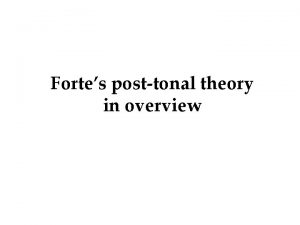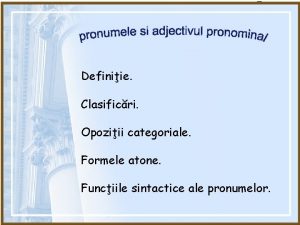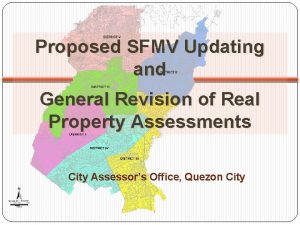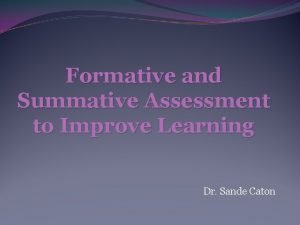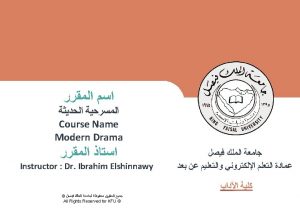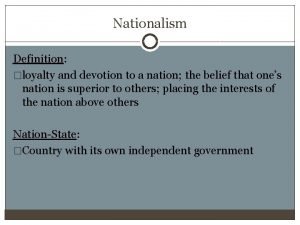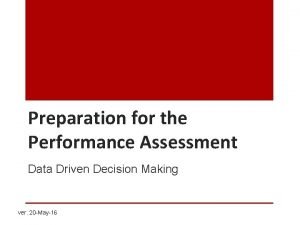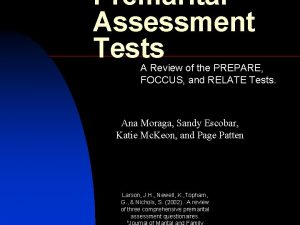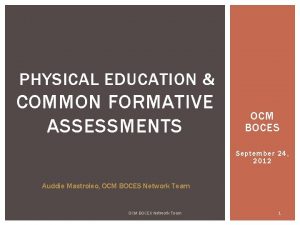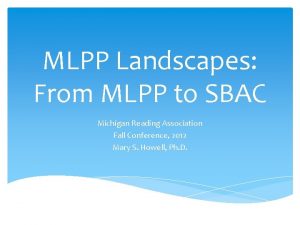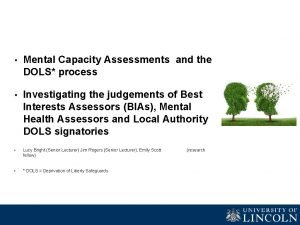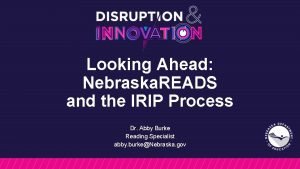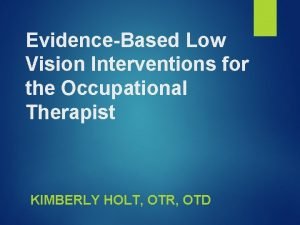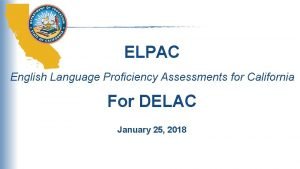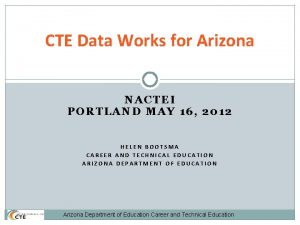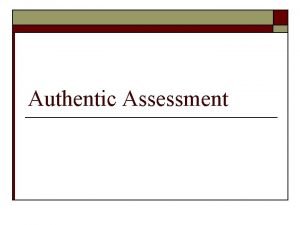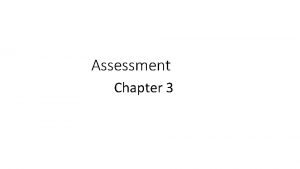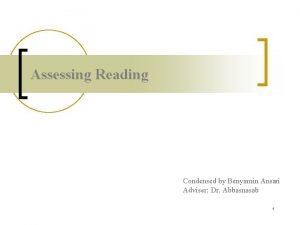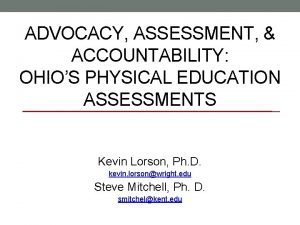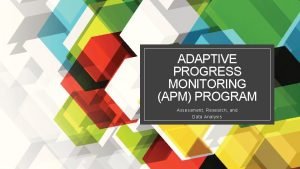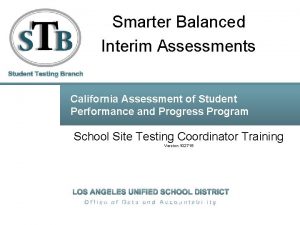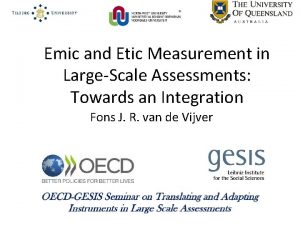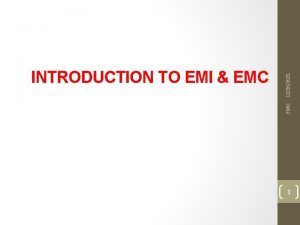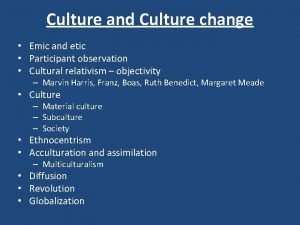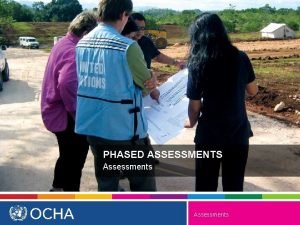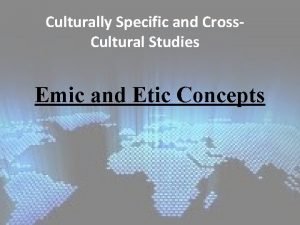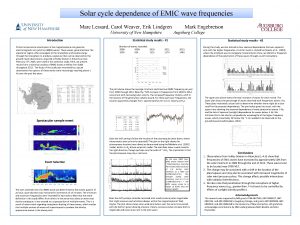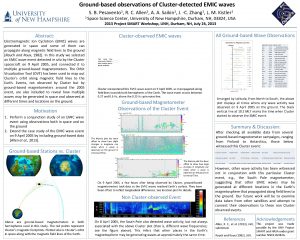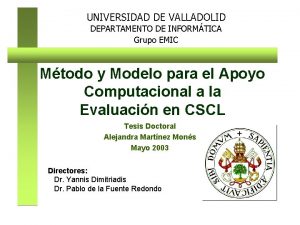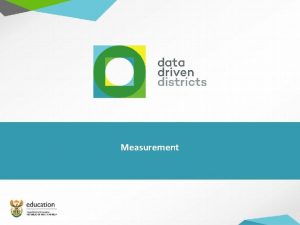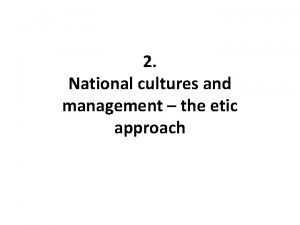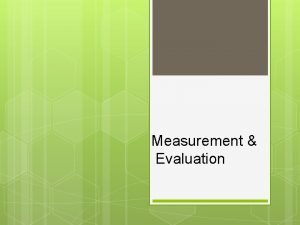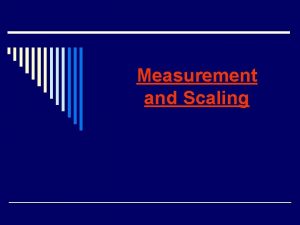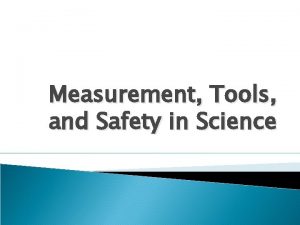Emic and Etic Measurement in LargeScale Assessments Towards



































- Slides: 35

Emic and Etic Measurement in Large-Scale Assessments: Towards an Integration Fons J. R. van de Vijver

Structure • Focus in large-scale assessment on asking identical questions (etic approach) • Emic—etic distinction – Relevance for large-scale assessment • From a dichotomy to complementarity • Example: personality assessment • Implications for large-scale assessment

N of Countries in Large-Scale Assessment • Programme for International Student Achievement (PISA): 78 countries (2018) • Starting Strong Survey (3 S): 9 countries (2018) • Teaching and Learning International Survey (TALIS): 48 countries (2018) • Programme for the International Assessment of Adult Competencies (PIAAC): 47 countries

Current Paradoxes of Large-Scale Assessments Due to Growth • General: Growth is accompanied by paradoxes/trade-offs • Increase in number of countries (with increase in cultural variation) will simultaneously make such – studies more informative for all stakeholders (countries, policymakers, scientists, …) – studies more difficult to conduct (e. g. , adaptation issues)

• Analysis paradox: more countries, fewer conclusions can be drawn – Scalar invariance as the desired/required, yet impossible goal • Test design paradox: more countries, less cultural coverage – Focus on what has at least some relevance in all countries Can easily gravitate towards Western-based stimuli (common to most OECD countries); Wober (1969): “How well can they do our tricks? ” • Test length paradox: more items, more design and analysis problems – Long instruments are both desirable and undesirable (paradox that long instruments are more informative, yet less likely to show high level of invariance)

Ways Forward? • Maintain that more countries and longer instruments are more informative, but… – Adjust/refine invariance procedures • OECD conference later this year on this topic • Relax the framework that only identical stimuli can be used and are informative as the framework will increasingly become a straitjacket – This approach will be further explored here

Need to Combine Universal and Culture-Specific Elements • Psychological phenomena are typically neither completely universal, nor completely culture specific • More universalism at a higher level of abstraction (extroversion) than at a lower level (indicators of extroversion)

As a Venn Diagram: Construct X in Three Countries • Large-scale assessment now focuses on the intersection • Yet, any subset can add validity to specific comparisons or enhance internal consistency

Options • Adoption (Close, “literal” translation) – Advantage: maintains metric equivalence – Disadvantage: adequacy (too) readily assumed, should be demonstrated • Adaptation (changing contents of one or more items so as to increase cultural appropriateness) – Advantage: more flexible, more tailored to the context – Disadvantage: fewer statistical techniques available to compare scores across cultures • Assembly (composing a new instrument) – Advantage: very flexible – Disadvantage: almost no comparability maintained

Taxonomy of Adaptations Adaptation as generic term; Need for adaptation can be due to: Construct equivalence • Similarity of construct in source and target culture Cultural equivalence Linguistic equivalence • Norms about interaction (modes of address) • “Cultural fact sheet” • Translation accuracy: Retention of denotation and connotation Measurement equivalence • Retention of psychometric features (response styles) • Similarity of factors measured by a test and comparability of scores

A Note on the Term “Adaptation” • Adaptations are always meant to enhance ecological validity, but… • “Minimum definition”: In OECD studies placeholders are often used when developing instruments – Involving places where a close translation would not work, but where the rest of the item remains intact • “Maximum definition”: Adaptation as inserting or replacing items

Emic-etic in personality research

• Pike (1967): – "Emic“: an emic account comes from a person within the culture; indigenous perspective • E. g. , what is intelligence in rural Zambia? – "Etic“: account is a description of a behavior or belief by an observer, in terms that can be applied to other cultures • E. g. , is the structure of intelligence universal? • Long considered to be conflicting

Example: (In)completeness of the Five-Factor Model Financially supported by NRF and SANPAD • The SAPI, an acronym for South African Personality Inventory, is a project that aims to develop an indigenous personality measure for all 11 official languages in South Africa. Participants are Byron Adams (University of Johannesburg and Tilburg University, the Netherlands), Deon de Bruin (University of Johannesburg), Karina de Bruin (University of Johannesburg), Carin Hill (University of Johannesburg), Leon Jackson (North-West University), Deon Meiring (University of Pretoria and University of Stellenbosch), Alewyn Nel (North-West University), Ian Rothmann (North-West University), Michael Temane (North-West University), Velichko Valchev (Tilburg University, the Netherlands), and Fons van de Vijver (North-West University and Tilburg University, the Netherlands).

Cross-Cultural Personality Models Universality (etic approach) – Using imposed etic concepts – emphasizes universals or core similarities in all human beings – Are the imposed etic personality constructs universally applicable? Cultural specificity (emic approach) – Utilizes a culture-specific orientation - emic concepts – Indigenous and culturally relevant constructs may be missing – Are there personality characteristics that are important to the understanding of personality in the local culture that have been left out in Western measures?

Personality: Evidence for Universality • Evidence largely based on two lines of research • 1. Five-Factor Model (Costa, Mc. Crae) – Five factors: Neuroticism, Extroversion, Openness, Agreeableness, Conscientiousness • 2. Three-Factor Model (Eysenck) – Three factors: Extroversion, Neuroticism, Psychoticism

Evidence for Cultural Specificity • • • Chinese concepts of interpersonal relatedness Japanese concept of amae (sweet indulgence) Korean concept of chong (affection) Indian concept of selfless self South-African concept of Ubuntu “Meaning” – – "humanity towards others" "I am because we are" "A person 'becomes human' through other persons" "A person is a person because of other persons"

Emic versus Etic or Emic and Etic? • Personality is neither completely universal, nor completely culture-specific • In retrospect, it is difficult to see how only one perspective could be presented as THE perspective • Emic and Etic instead of Emic vs. Etic • How can we combine the two? – Much evidence in cross-cultural psychology that basic structure of psychological functioning is universal, but manifestations can differ across cultures

Languages of South Africa Language % Zulu 23. 8% Xhosa 17. 6% Afrikaans 13. 3% Northern Sotho 9. 4% Tswana 8. 2% English 8. 2% Sotho 7. 9% Tsonga 4. 4% Swati 2. 7% Venda 2. 3% Ndebele 1. 6% Other languages 0. 5% http: //en. wikipedia. org/wiki/File: South_Africa_municipalities_by_language_2001. png

• Aim SAPI Project – No test available with demonstrated validity in all groups – Develop a personality instrument for South Africa that can accommodate its diversity • Stages 1. Qualitative Stage – Identifying personality structure in an indigenous, comparative study – Generating and piloting items/scales 2. Quantitative Stage

Method • Participants • Adults from all eleven language groups • Sample guidelines: Socio-economic Status, Education (low, medium, High), Males/Females, Age (18 -35 yrs & 35 older) • Interview done in participant’s first language • Instrument • Person descriptions of familiar persons • Your own personality – Describe yourself • A parent • ….

Stages in Data Analysis • Phase 1 – Preparing Data • Translations • Removing synonyms, … • Phase 2 – Iterations of • Condensing data • Consulting language and cultural experts • Phase 3: – Conceptual Cluster Analysis 22

Condensing the Data Facets abusive (34) Categorising Cleaning Response in English Response in Ndebele abusive abused He is abused Uhlukulumezekile epilweni abusive abused him he abused him even when abuse was not there kade ambuser lokha ingekho abusive abuses me He abuses me Uyangi hlukumeza abusive Abusive person An abusive person Umuntu ohlukumezako

SOFTHEARTEDNESS RELATIONSHIP HARMONY Conflict Seeking Meddlesomeness Hostility Amiability Interpersonal Relatedness Egoism Active support Approachability FACILITATIN G Gratefulness Guidance Empathy EXTRAVERSIO N Dominance CONSCIENTIOUSNES S Sociability Expressiveness Positive Emotionality Dedication Achievement Orientation EMOTIONAL STABILITY Emotional Control Emotional Sensitivity Neuroticism Balance Epistemic Curiosity Integrity Fairness Orderliness INTELLEC T OPENNES S Materialism INTEGRIT Y Thoughtlessness Self-discipline Ego Strength Encouraging others Broadmindedness Openness to Experience Aesthetics Skillfulness Reasoning Social Intellect

Cluster: Relationship Harmony Subcluster Approachability Conflict-Seeking Facet Example Response (Language) Accommodating Addressed us in English so we could understand (Xhosa) Approachable She is approachable, I could speak to her about anything (S Sotho) Arrogant He thinks he is better than all the other people (N Sotho) Flexible to situation (Tswana) Humble She is a humble and down to earth person (Ndebele) Open for Others Accepts people for who and what they are (English) Proud Is proud and thinks of herself better than others (Swati) Stubborn Was stubborn, did not listen to anybody (Tswana) Tolerant (Afrikaans) Welcoming – to everyone (Venda) Argumentative Likes to quarrel (Xhosa) Provoking Provocative and calls people names (Swati) Troublesome Creates tension for nothing (Zulu)

Cluster: Soft-Heartedness Active Support Community Involvement (11/143) There is one person who is always looking after the community (Zulu) Heedful She listens when you talk to her (S Sotho) Helpful Is helpful when you are in need (Swati) Protective (Xhosa) Solving Problems of Others If I have a problem, she knows how to solve it (Ndebele) Amiability Egoism Supportive I like to give people my support (Tswana) Friendly She is a friendly person (Tsonga) Irritating He is annoying and irritating (S Sotho) Kind (Venda) Likeable He is loved by everyone (S Sotho) Pleasant He was a nice person to live with (Zulu) Stern Always serious, not smiling (Xhosa) Generous One who is generous and gives food when asked (Swati) Greedy (Afrikaans) Jealous A person who is jealous of other people’s possessions (Zulu) Self-Centered All revolves around her, she thinks (English) Selfish Wants everything for himself (Xhosa)

Quantitative Findings • 262 items (incl. 12 SD items) administered to 1, 364 students and community adults • 671 Blacks, 198 Coloureds, 104 Indians, 391 Whites • EFA per cluster; items with loadings <. 30 or. 40 were removed • 158 items in latest version (incl. 12 Social Desirability items) • 18 empirically derived scales • EFA on scale scores 27

Cronbach’s alpha Black Coloured Indian White Facilitating (10) . 84 . 85 . 87 . 88 Integrity (12) . 76 . 83 . 84 . 79 Social Intellect (4) . 71 . 75 . 82 . 74 Interpersonal Relatedness (9) . 77 . 81 . 83 . 78 Warm-Heartedness (12) . 83 . 89 . 83 . 87 Deceitfulness (3) . 58 . 59 . 75 . 53 Conflict-Seeking (6) . 67 . 70 . 71 . 64 Hostility–Egoism (13) . 80 . 84 . 89 . 83 Emotional Balance (8) . 71 . 77 . 73 . 74 Negative Emotionality (10) . 75 . 73 . 76 . 77 Playfulness (6) . 71 . 76 . 84 . 81 Sociability (7) . 75 . 80 . 84 . 86 Achievement Orientation (10) . 79 . 78 . 81 . 82 Orderliness (11) . 81 . 85 . 88 . 86 Traditionalism–Religiosity (4) . 57 . 65 . 78 . 75 Intellect (10) . 74 . 81 . 79 . 76 Broad-Mindedness (5) . 60 . 66 . 72 . 75 Epistemic Curiosity (6) . 66 . 77 . 83 . 80 Scale (# items) 28

SAPI Structure 29

RELATIONSHIP HARMONY Conflict Seeking Meddlesomeness Qualitative SOFTHEARTEDNESS Hostility Amiability Interpersonal Relatedness Egoism Active support Approachability FACILITATIN G Gratefulness Guidance Empathy EXTRAVERSIO N Dominance CONSCIENTIOUSNES S Sociability Expressiveness Positive Emotionality Achievement Orientation Thoughtlessness EMOTIONAL STABILITY Emotional Control Emotional Sensitivity INTEGRIT Y Dedication Self-discipline Ego Strength Encouraging others Integrity Fairness Orderliness INTELLECT Courage Neuroticism Balance OPENNES S Materialism Epistemic Curiosity Broadmindedness Openness to Experience Aesthetics Skillfulness Reasoning Social Intellect 30

Quantitative SOCREL POSITIVE SOCREL NEGATIVE Conflict Seeking Interpersonal Relatedness Facilitating Hostile Egoism Deceitfulness Warm. Heartedness Social Intelligence EXTRAVERSIO N Playfulness Sociability CONSCIENTIOUSNES S Orderliness Integrity Achievement Orientation Emotional Maturity Traditionalism Religiosity NEUROTICISM Negative Emotionality INTELLECT / OPENNES S Intellect Epistemic Curiosity Broadmindedness 31

Conclusion • Both emic and etic factors were found – Emic notably in the social-relational domain • Five Factor Model well replicated for N, E, O, C • If we would have started by applying a standard Big Five/FFM instrument, the salience of social relational aspects would never have been found

Emic and Etic in Large-Scale Studies • Etic/one-size-fits-all approach has strengths – Allows for cross-cultural comparisons – Is efficient (can use short instruments) – Can often rely on tried-and-tested instruments • Etic/one-size-fits-all approach has limitations – Focus on short instruments • Construct coverage can become problematic – Focus on what is shared across cultures, which will become less and less when cultural variation is increased

• Combined emic—etic approach would amount to adding culture-specific items to etic measures – Note: different from international option that involves all items about a construct • Emic approach can help to – – Increase ecological validity of instruments Increase construct coverage Enhance validity and internal consistency in cultures Overcome the criticism that large-scale assessments can show Western bias • Note: item response theory can deal with the combination of etic and emic items (cf. matrix designs)

Global Conclusion • From emic versus etic to emic and etic • Emphasis on identical questions in large-scale assessment (“one-size-fits-all”) becomes problematic with the increased cultural/linguistic diversity of large-scale assessments • Culture-specific items may help policy makers
 Etics and emics examples
Etics and emics examples Emic vs etic
Emic vs etic Definición de cultura
Definición de cultura Pozzetto di cacciata emic
Pozzetto di cacciata emic Emic forte
Emic forte Dativul etic
Dativul etic Educatia este arta de a face omul etic
Educatia este arta de a face omul etic Mag etic
Mag etic Etic moral
Etic moral General revision of assessments and property classification
General revision of assessments and property classification Informal and formal assessment
Informal and formal assessment Informal and formal assessment
Informal and formal assessment Formative assessments
Formative assessments What is physical fitness test in mapeh
What is physical fitness test in mapeh Formative test
Formative test Compare torvald and nora's attitude towards money
Compare torvald and nora's attitude towards money Refers to the loyalty and devotion to a nation
Refers to the loyalty and devotion to a nation Performance assessments examples
Performance assessments examples Premarital tests or assessments
Premarital tests or assessments Common formative assessment examples
Common formative assessment examples Scoring rubrics for designing a museum exhibit
Scoring rubrics for designing a museum exhibit Mlpp assessments
Mlpp assessments Six dols assessments
Six dols assessments Nebraska reads approved assessments
Nebraska reads approved assessments Ls&s low vision
Ls&s low vision Elpac summative score ranges
Elpac summative score ranges Cte technical skills assessments.azed.gov/student
Cte technical skills assessments.azed.gov/student Creative arts grade 8 visual art
Creative arts grade 8 visual art What does olivia mean
What does olivia mean Authentic task
Authentic task Characteristics of psychological test
Characteristics of psychological test Beben benyamin
Beben benyamin Physical education assessments examples
Physical education assessments examples Apm testing florida
Apm testing florida Sat subscores
Sat subscores Lausd interim assessments
Lausd interim assessments




